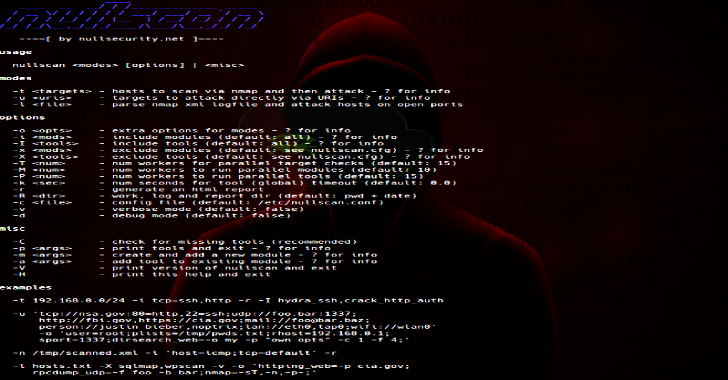NullScan is a modular framework designed to chain and automate security tests. It parses target definitions from the command line and runs corresponding modules and their nullscan-tools afterwards.
It can also take hosts and start nmap first in order to perform a basic portscan and run the modules afterwards. Also, nullscan can parse a given nmap logfile for open tcp and udp ports and again run the modules afterwards.
All results will be logged in specified directories with a clean structure and a HTML report can subsequently be generated.
Usage
[ hacker@blackarch ~ ]$ nullscan -H
–==[ by nullsecurity.net ]==–
Usage
nullscan <modes> [options] | <misc>
Modes
-t <targets> – hosts to scan via nmap and then attack – ? for info
-u <uris> – targets to attack directly via URIs – ? for info
-l <file> – parse nmap xml logfile and attack hosts on open ports
Options
-o<opts> – extra options for modes – ? for info
-i<mods> – include modules (default: all) – ? for info
-I <tools> – include tools (default: all) – ? for info
-x <mods> – exclude modules (default: see nullscan.cfg) – ? for info
-X <tools> – exclude tools (default: see nullscan.cfg) – ? for info
-T <num> – num workers for parallel target checks (default: 15)
-M <num> – num workers to run parallel modules (default: 10)
-P <num> -workers to run parallel tools (default: 15)
-k <sec> – seconds for tool (global) timeout (default: 0.0)
-r – generate an html report
-R <dir> – work, log and report dir (default: pwd + date)
-c <file> – config file (default: /etc/nullscan.conf)
-v – verbose mode (default: false)
-d – debug mode (default: false)
Misc
-C – check for missing tools (recommended)
-p <args> – print tools and exit – ? for info
-m <args>- create and add a new module – ? for info
-a <args>- add tool to existing module – ? for info
-V – print version of nullscan and exit
-H – print this help and exit
Examples
-t 192.168.0.0/24 -i tcp=ssh,http -r -I hydra_ssh,crack_http_auth
-u ‘tcp://nsa.gov:80=http,22=ssh;udp://foo.bar:1337;
http://fbi.gov,https://cia.gov;mail://foo@bar.baz;
person://justin bieber,noptrix;lan://eth0,tap0;wifi://wlan0′
-o ‘user=root;plists=/tmp/pwds.txt;rhost=192.168.0.1;
sport=1337;dirsearch_web=-o my -p “own opts” -c 1 -f 4;’
-n /tmp/scanned.xml -i ‘host=icmp;tcp=default’ -r
-l hosts.txt -X sqlmap,wpscan -v -o ‘httping_web=-p cia.gov;
rpcdump_udp=-f foo -b bar;nmap=-sT,-n,-p-;’
-p ‘tcp=ssh,http;host=zonetransfer;udp’
-m ‘icmp/ping ping_flood ping -f -s 9999’
-a ‘tcp/ssh crack_ssh sshcracker -c arg -f arg’
Also Read – goBox : GO Sandbox To Run Untrusted Code
Installation
Run setup.sh. Install needed python modules afterwards using pip install -r docs/requirements.txt.
Notes
- Please check the manpage from docs/nullscan.1
- Use ‘?’ option-value for any cmdline options. It gives you information for usage and examples.
- clean code; real project
- nullscan is already packaged and available for BlackArch Linux
- My master-branches are always stable; dev-branches are created for current work.
- All of my public stuff you find are officially announced and published via nullsecurity.net.
Disclaimer
We hereby emphasize, that the hacking related stuff found on nullsecurity.net are only for education purposes. We are not responsible for any damages. You are responsible for your own actions.
Credit: noptrix
















